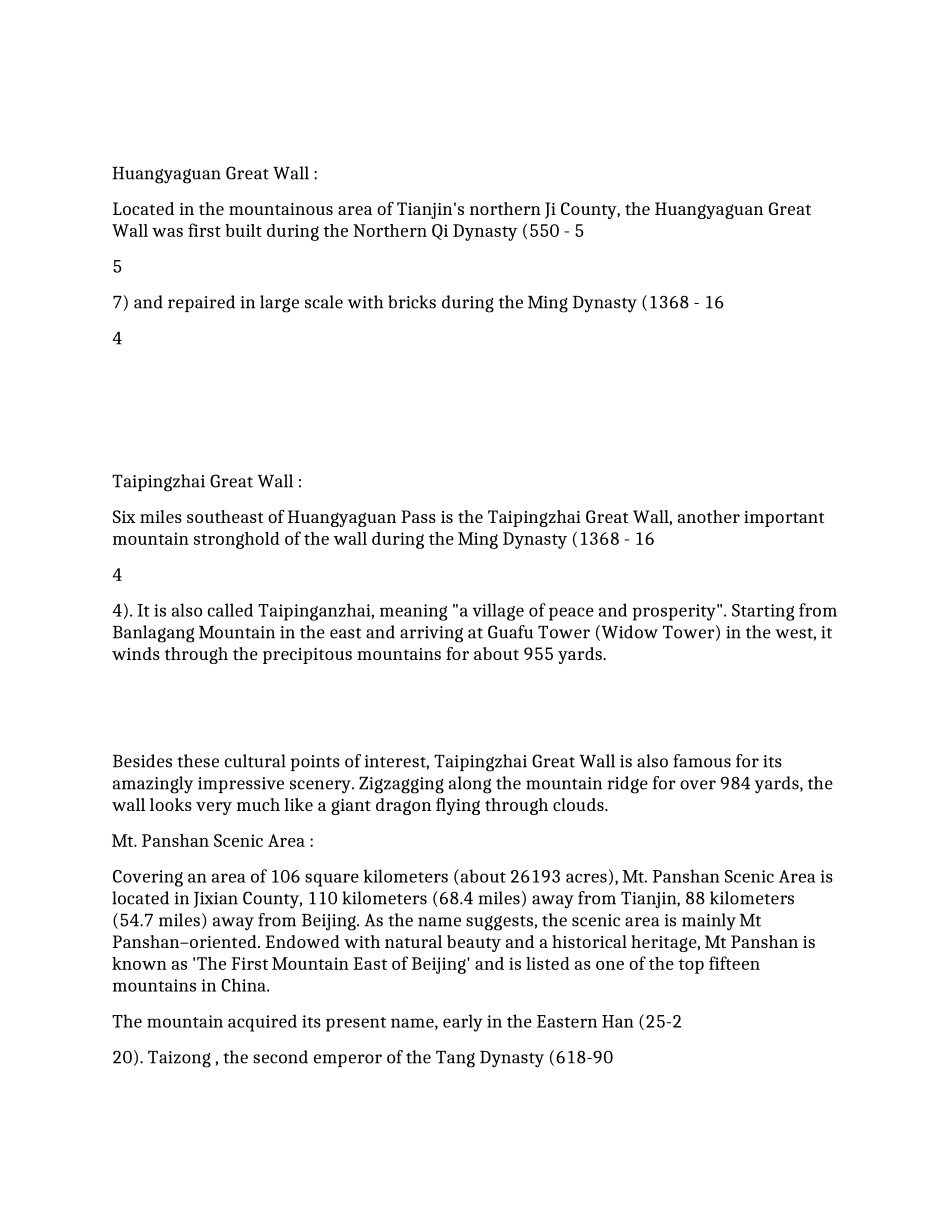Huangyaguan Great Wall :Located in the mountainous area of Tianjin's northern Ji County, the Huangyaguan Great Wall was first built during the Northern Qi Dynasty (550 - 557) and repaired in large scale with bricks during the Ming Dynasty (1368 - 164Taipingzhai Great Wall :Six miles southeast of Huangyaguan Pass is the Taipingzhai Great Wall, another important mountain stronghold of the wall during the Ming Dynasty (1368 - 1644). It is also called Taipinganzhai, meaning "a village of peace and prosperity". Starting from Banlagang Mountain in the east and arriving at Guafu Tower (Widow Tower) in the west, it winds through the precipitous mountains for about 955 yards.Besides these cultural points of interest, Taipingzhai Great Wall is also famous for its amazingly impressive scenery. Zigzagging along the mountain ridge for over 984 yards, the wall looks very much like a giant dragon flying through clouds.Mt. Panshan Scenic Area :Covering an area of 106 square kilometers (about 26193 acres), Mt. Panshan Scenic Area is located in Jixian County, 110 kilometers (68.4 miles) away from Tianjin, 88 kilometers (54.7 miles) away from Beijing. As the name suggests, the scenic area is mainly Mt Panshan–oriented. Endowed with natural beauty and a historical heritage, Mt Panshan is known as 'The First Mountain East of Beijing' and is listed as one of the top fifteen mountains in China.The mountain acquired its present name, early in the Eastern Han (25-220). Taizong , the second emperor of the Tang Dynasty (618-907), was prodigal of his praise of its scenery on his chance visit when he led the army in a campaign. Seventy-two temples, thirteen pagodas and numerous Xanadus and towers were built on the mountain in the Ming Dynasty (1368-1644) and the Qing Dynasty (1644-1911). Qianlong, a brilliant and wise Qing Dynasty emperor was so impressed that he made thirty or so visits and wrote 1366 poems to express his admiration of the area. In the first half of the twentieth century, the whole resort all fell to ruin due to hostilities and neglect. It has undergone a process of restoration since the 1990s and is now regaining its fame.It is famous for jade pine trees, strange and astonishing peaks, clear waters, grotesquely shaped rocks and clusters of ancient temples. On the mountaintop, numerous pines hide the sky from view and block out the sunshine. Rugged rocks in a variety of shapes, some of which resemble a toad, a general or a boa, will greet you in the middle of the mountain. At its foot, clear water splashes on the rocks. The mountain consists of five peaks, with the main one, Guayue (Moon Hanging) Peak. Although Guayue Peak is only 857 meters (2811.7 feet) above sea level, to the north it is possible to see a section of the Great Wall while to the west Mt Taihang can be seen.From the Wei State during the Three Kingdoms Period (220-2

